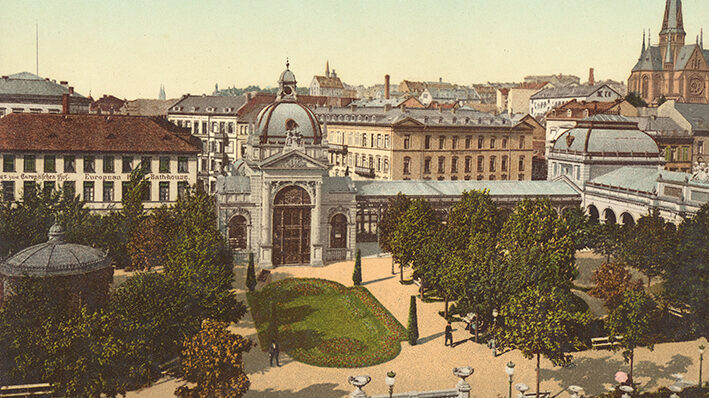City history compact
The development of Wiesbaden from Roman times to the 19th century
Wiesbaden was called "Aquae Mattiacorum" by the Romans - after the Mattiacs, a tribe of Germanic Chatti who lived here and whose members presumably mixed with the original Celtic population early on. Traces of settlement in the city area have been found as early as the Neolithic period around 3000 BC. A first military post (earth fort) on the Heidenberg can be dated to the late Augustan period around six to 15 AD; the development of a civilian Roman settlement began a little later with the expansion of the thermal baths. This was fortified with a wall around 370 - the remains of this so-called Heidenmauer can still be seen today.
At the end of the fourth century, the Alemanni took over the protection of Wiesbaden as a Mainz bridgehead, and around a century later the Franks began to settle here. The town was already the seat of a royal court in Merovingian times and was first referred to as "Wisabada" in 828/30. From the late Middle Ages, Wiesbaden belonged to the Counts of Nassau. In the 13th century, it was temporarily an imperial city until its destruction by the Archbishop of Mainz in 1242. In 1547 and 1561, fires destroyed almost all of the medieval buildings. The Thirty Years' War also had devastating effects. However, from 1690 onwards, the town, which only had around 730 inhabitants at the time, was expanded and refortified. In 1744, Prince Karl von Nassau-Usingen moved his residence to Biebrich Palace; Wiesbaden became the seat of the government of the principality, later the Duchy of Nassau (1806 to 1866).
Wiesbaden becomes a "world spa city"
In the 19th century, the town developed into an international health resort. The annexation of Nassau by Prussia in 1866 did nothing to stop Wiesbaden's upswing. Wiesbaden became the capital of a government district and a popular retirement home for officers, senior civil servants and pensioners who lived off their pensions or the interest on their assets. The cityscape was characterized by prestigious residential buildings, hotel palaces and elegant villas. The population grew rapidly and exceeded 100,000 inhabitants in 1905.
The First World War, the subsequent French and British occupation until 1930 and the Great Depression considerably weakened the city's financial strength; even the incorporation of suburbs in 1926 and 1928 did little to change this. Wiesbaden had lost its former significance as a "world spa town".
National Socialism, the Second World War and afterwards
Numerous offices of the Nazi regime of injustice were located in Wiesbaden from 1933 onwards. Jews and Sinti were also deported from here. Many Wiesbaden residents of various political persuasions were persecuted for opposing the regime.
After suffering comparatively little damage during the Second World War, Wiesbaden became the capital of the state of Hesse in 1945, where numerous publishing houses, insurance companies and film industry businesses settled alongside government offices. Wiesbaden also plays a prominent role as a spa and congress city and as one of the preferred places to live in the Rhine-Main region.
Contact us
City archive
Address
65197 Wiesbaden
Postal address
65029 Wiesbaden
Arrival
Notes on public transport
Public transportation: Bus stop Kleinfeldchen/Stadtarchiv, bus lines 4, 17, 23, 24 and 27 and bus stop Künstlerviertel/Stadtarchiv, bus line 18.
Telephone
- +49 611 313022
- +49 611 313977
Opening hours
Opening hours of the reading room:
- Monday: 9 a.m. to 12 p.m.
- Tuesday: 9 am to 4 pm
- Wednesday: 9 am to 6 pm
- Thursday: 12 to 16 o'clock
- Friday: closed
